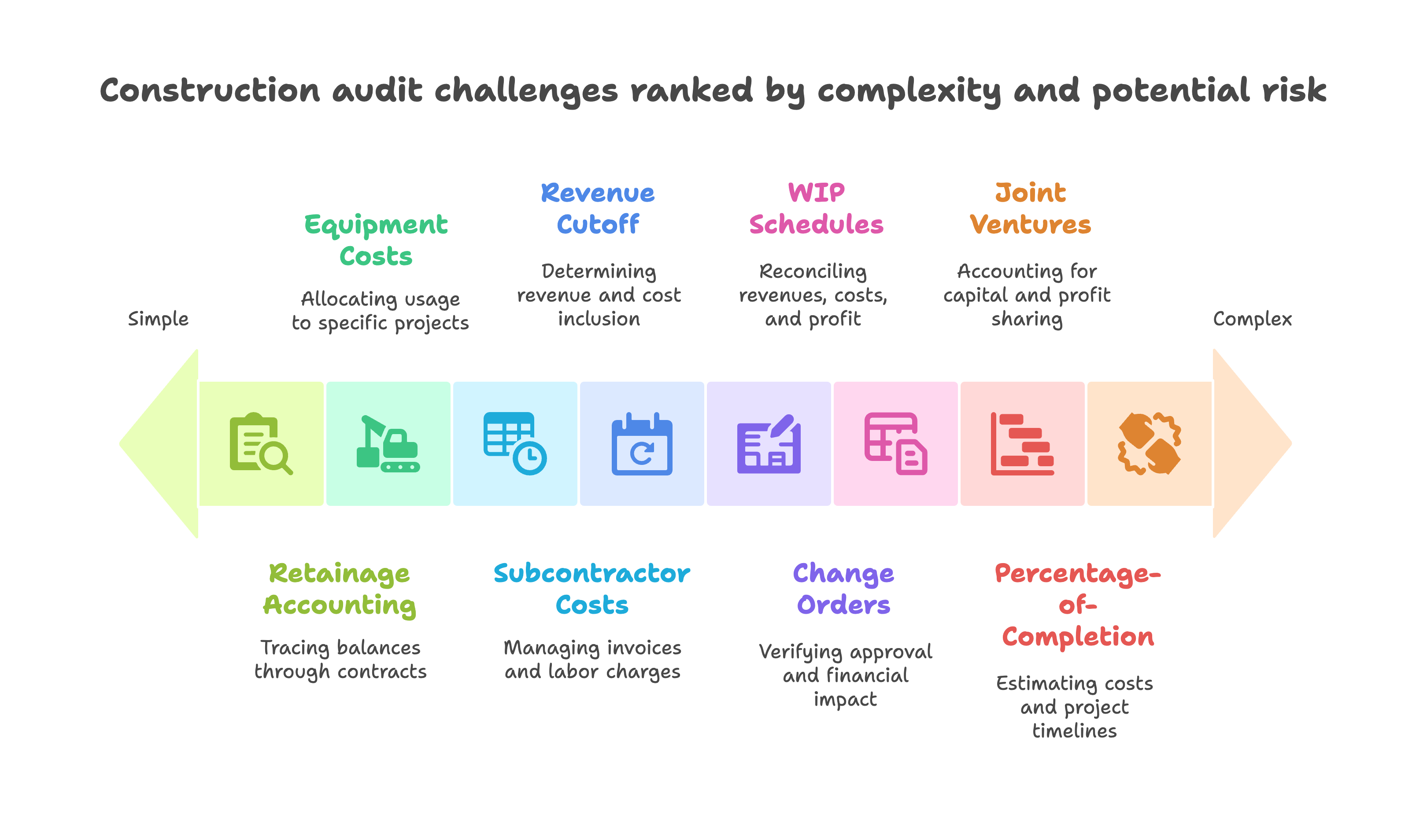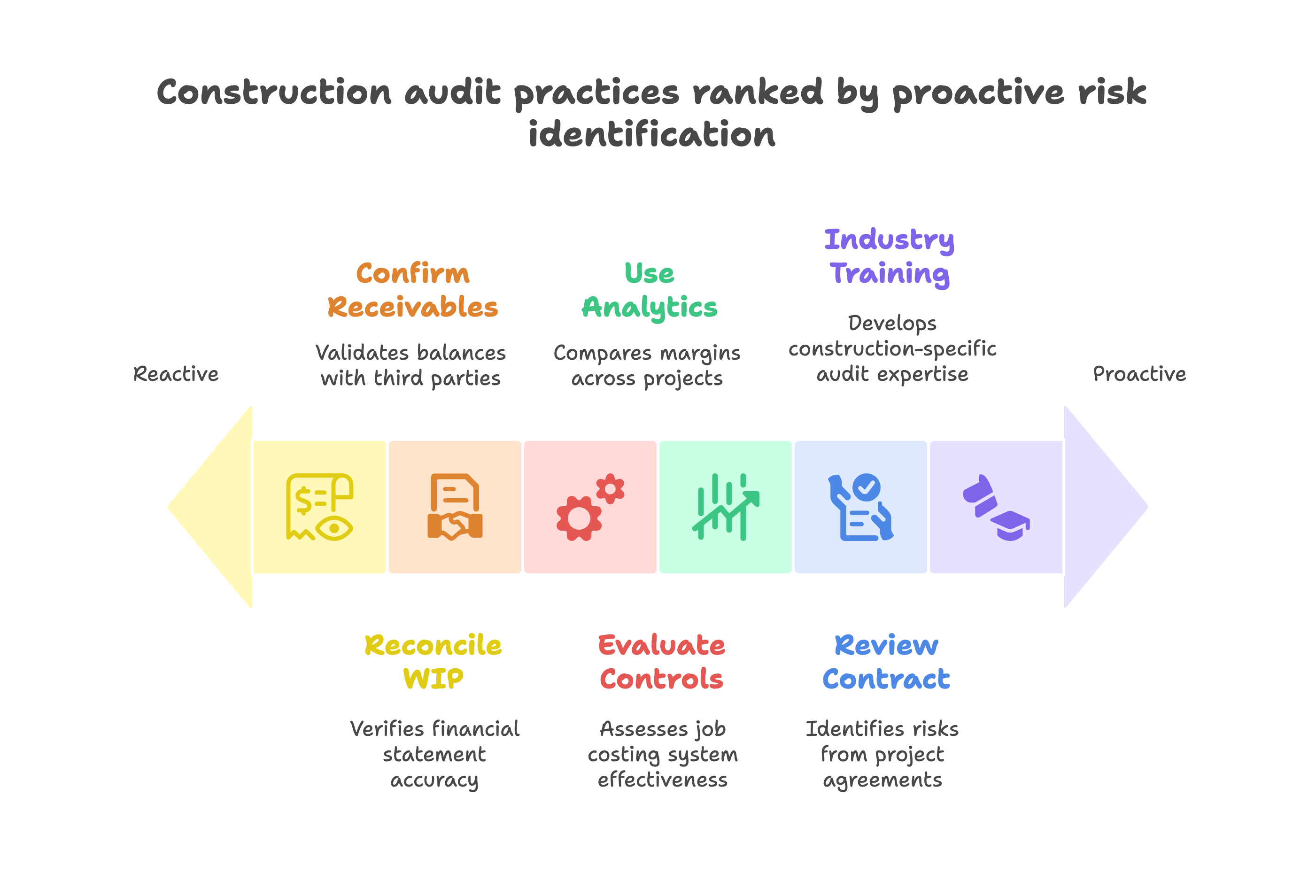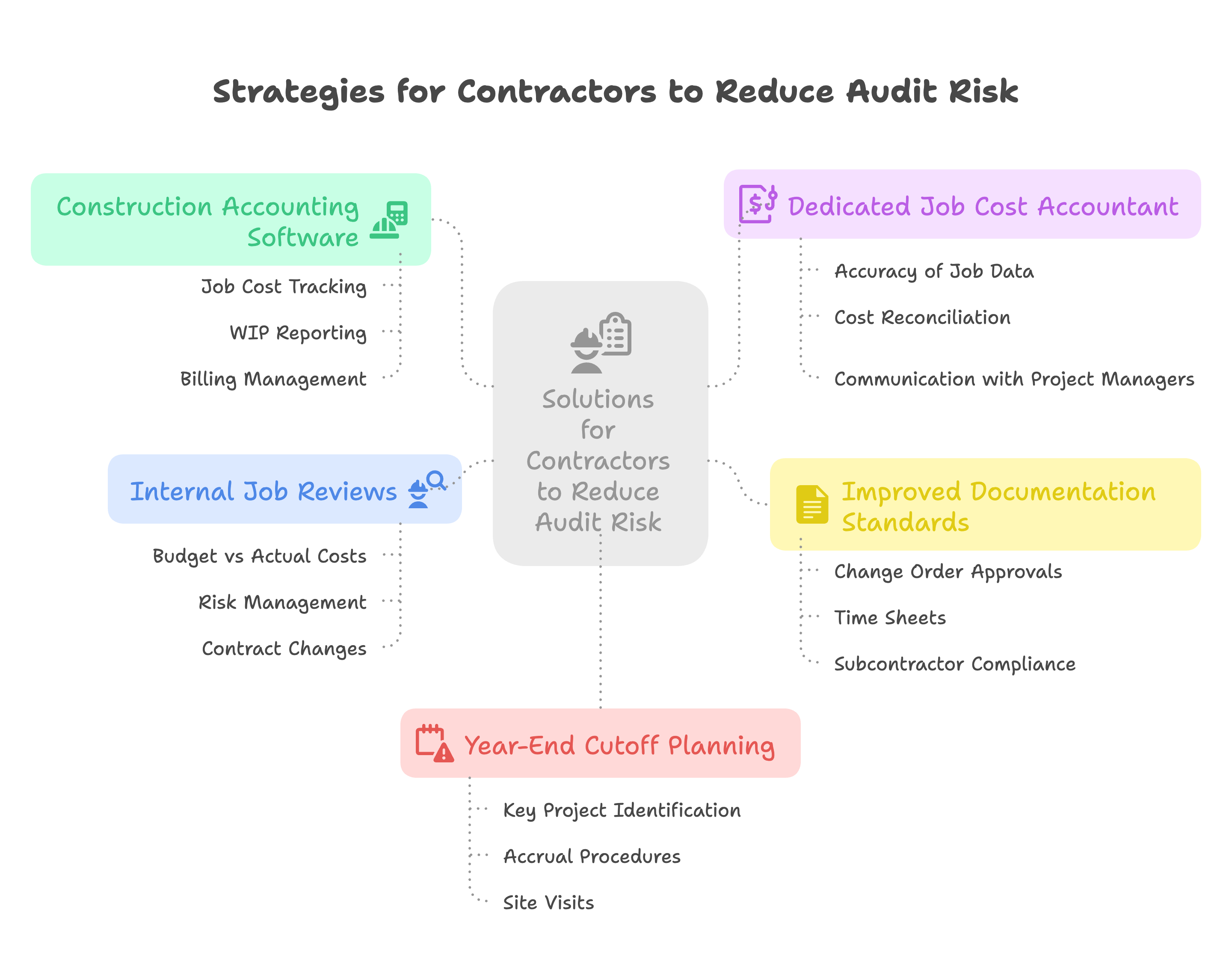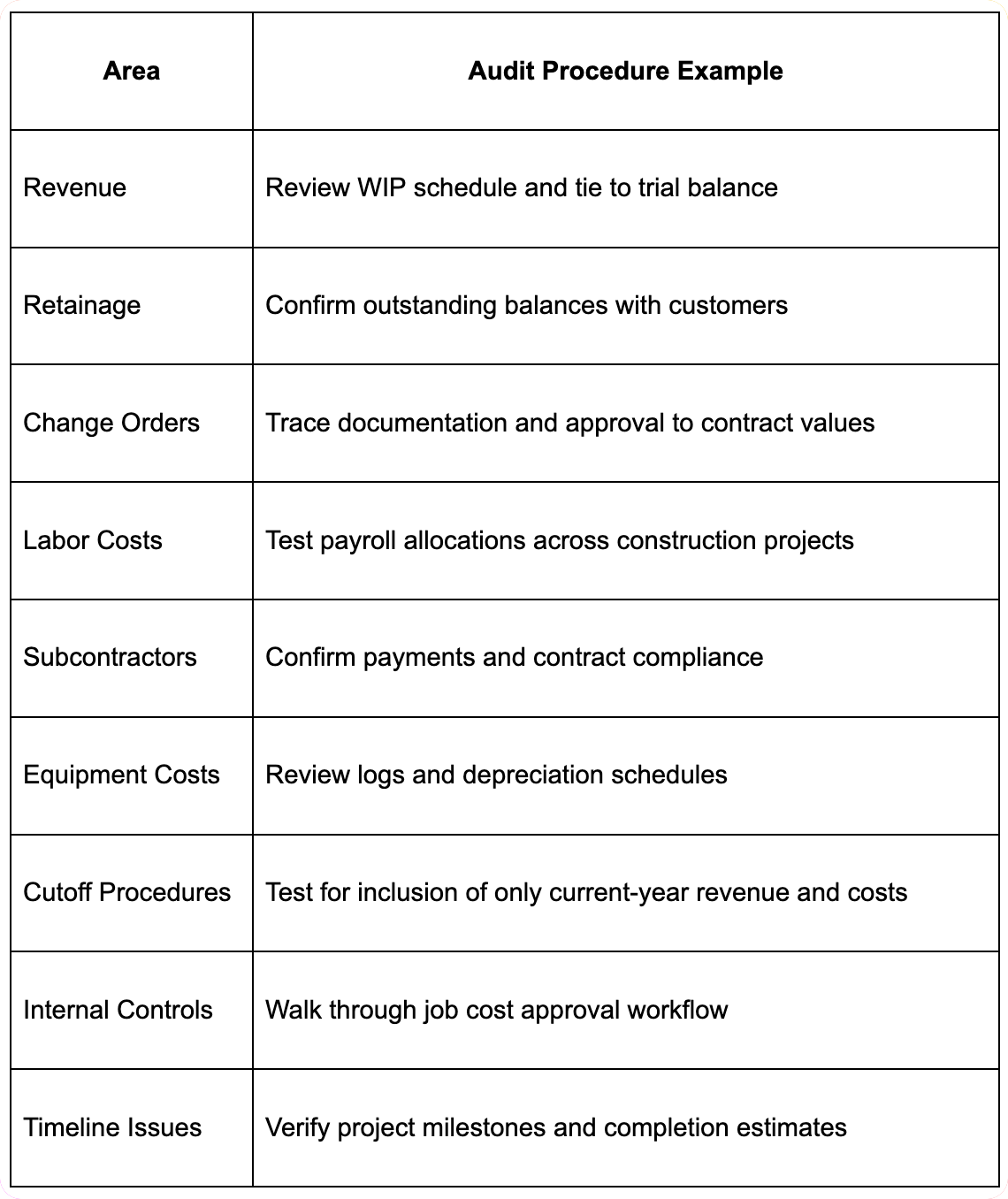The construction industry presents some of the most complex challenges in the accounting and audit world. With long-term contracts, percentage-of-completion revenue models, subcontractor arrangements, change orders, joint ventures, and labor-intensive operations, every contractor faces a minefield of accounting variables that make accurate reporting difficult.
For CPA firms, conducting a construction audit demands not only technical skill but also a working knowledge of how the construction industry operates. Misunderstanding revenue recognition timing, misclassifying labor costs, or failing to account for retainage properly can lead to audit findings, tax penalties, or lost bonding capacity for any contractor.
Understanding potential risks and implementing effective risk management strategies is crucial for both auditors and construction companies. A well-planned construction audit can help stakeholders identify issues early and optimize operations for better financial performance.
This guide explores the most common audit challenges faced in the construction industry and outlines how both contractors and audit firms can overcome them. Whether your goal is compliance, operational improvement, or securing larger bonding lines, understanding these issues is critical for project success.
The construction industry is project-based, which brings several consequences that make each construction audit particularly complex:
From an audit perspective, this creates special risks related to:
An experienced auditor must design procedures to address these complexities while helping management improve internal financial visibility. The audit process in construction requires specialized knowledge that goes beyond standard audit procedures.
Revenue on long-term contracts is often recognized using the percentage-of-completion method, meaning income is recorded as work is completed, not when payments are received. This requires accurate estimates of:
An auditor must evaluate the accuracy of these inputs and ensure they are based on reasonable assumptions. Small errors in cost estimation can lead to large swings in reported revenue, creating significant potential risks for stakeholders.
Common issues:
The WIP schedule is one of the most important documents in a construction audit. It reconciles contract revenues, costs, billings, and gross profit across all active construction projects.
Audit challenges include:
WIP errors affect revenue, income, and balance sheet accounts like overbillings and underbillings. An experienced auditor will spend significant time validating these schedules.
Retainage refers to a portion of contract value withheld by the client until construction project completion. It is often 5 to 10 percent and can be substantial for any contractor.
Audit complications include:
CPA firms must trace retainage through contracts, invoices, and collections to ensure balances are accurate and properly reflected in financial statements.
Construction projects are rarely static. Change orders arise due to scope adjustments, design changes, or site conditions, creating additional audit complexity.
Audit concerns:
An auditor should verify that change orders are properly approved and included in revised contract values, ensuring all stakeholders understand the financial impact.
Subcontracted work and self-performed labor are often the largest expenses on a construction project. Yet many companies struggle with:
Strong internal controls over labor tracking and vendor management are essential to avoid audit findings and ensure accurate job costing.
Joint ventures are common for large-scale construction projects but bring added complexity to the audit process in accounting for:
The choice of accounting method depends on control and influence, and errors can misstate both income and assets for all stakeholders involved.
Construction firms often own or lease heavy equipment. Allocating equipment usage to specific construction projects correctly affects:
An auditor must check for improper capitalization, missing depreciation, or misapplied costs that could significantly impact financial statements.
Construction projects may be 90 percent complete at year-end. Determining whether to include costs, revenue, or retainage in the current or next period requires careful judgment and creates potential audit issues.
Common audit issues:
Clear procedures for revenue cutoff reduce these risks and help streamline the audit process for both auditors and contractors.

General audit knowledge is not enough for an effective construction audit. Firms should invest in:
This helps auditors speak the language and identify red flags faster, ultimately improving the quality of each construction audit.
Every construction project begins with a contract. Key clauses for an auditor to examine include:
This contract review sets the foundation for the entire audit approach and helps identify potential risks early in the process.
Many WIP issues stem from poor reconciliation between construction project records and financial statements. An auditor should ensure that:
Review of WIP schedules should be a core audit procedure in every construction audit.
Third-party confirmations, including retainage balances and contract status, provide crucial audit evidence and can uncover disputes or slow collections that might impact the contractor's financial position.
Construction firms need robust controls over:
CPA firms can help evaluate and improve these systems, providing value beyond the basic audit process.
Compare job margins across periods and construction project types. Large swings may indicate:
Benchmarking against industry data also provides useful context for evaluating a contractor's performance.

Systems like Sage 300 Construction, Viewpoint, or Procore help integrate:
Automation reduces manual errors and improves audit readiness, helping to streamline the overall audit process.
Separating financial accounting from project accounting improves:
This role bridges field operations and finance, ensuring that all stakeholders have access to accurate, timely information.
Keep comprehensive records of:
Standardizing documentation improves audit support and speeds up fieldwork, reducing the time and cost of each construction audit.
Monthly or quarterly construction project performance meetings should cover:
Involving both finance and operations teams ensures alignment and helps identify issues before they become major problems.
Coordinate with auditors ahead of year-end to:
Proactive planning minimizes post-year-end adjustments and helps streamline the audit process for all stakeholders.


Contemporary auditors can leverage technology to optimize the construction audit process:
When a contractor uses integrated construction management software, it can help the auditor:
Effective risk management in construction requires:
An auditor can enhance risk management by:
Contractors working on public construction projects may face additional requirements such as:
An auditor should inquire about these obligations and tailor procedures accordingly, ensuring that all regulatory requirements are properly addressed in the construction audit.
Construction projects typically involve numerous stakeholders:
An effective construction audit must address the needs of all these stakeholders while maintaining independence and objectivity.
Construction audit reports should:
Throughout the audit process, maintain communication with stakeholders about:
Auditing construction companies requires specialized knowledge, careful planning, and attention to the unique challenges of project-based accounting. The combination of long-term revenue recognition, complex cost allocation, labor-intensive execution, and regulatory scrutiny creates a demanding environment for both auditors and contractors.
A successful construction audit depends on understanding the specific challenges of each construction project and implementing appropriate procedures to address potential risks. CPA firms can serve as both auditors and advisors by helping construction clients implement better controls, track job performance accurately, and prepare audit-ready documentation.
Contractors who invest in job costing discipline, use integrated systems, and treat the audit process as a value-add activity will not only reduce audit risks but also improve profitability and project control. The key is to work collaboratively with all stakeholders to ensure that the construction audit provides meaningful insights that support better decision-making and risk management.
By following best practices, leveraging technology to streamline processes, and maintaining open communication with stakeholders, construction companies can optimize their audit experience and use it as a tool for continuous improvement. An effective construction audit should seamlessly integrate with the company's overall risk management and operational improvement strategies.
Question: What are the unique audit challenges specific to the construction industry?
Answer: Construction industry audit challenges include complex revenue recognition under percentage-of-completion accounting, job cost allocation accuracy, change order accounting, and long-term contract compliance. Auditors must evaluate contract terms, progress measurement methods, cost allocation systems, and estimated completion costs. Additional challenges cover bonding company requirements, lien waivers, retention accounting, and subcontractor compliance. Construction projects often span multiple years with significant estimates and judgments affecting financial statements. Equipment valuations, depreciation methods, and maintenance costs require specialized knowledge. Joint ventures, multi-location operations, and weather-related delays create additional audit complexities. Professional expertise in construction accounting standards and industry practices is essential for effective audit planning and execution.
Question: How should auditors approach revenue recognition testing for construction contracts?
Answer: Approach construction revenue recognition testing by evaluating contract terms, reviewing progress measurement methods, testing cost allocation systems, and validating estimated costs to completion. Examine contract documentation for scope, pricing, change order procedures, and completion criteria. Test percentage-of-completion calculations through physical observations, engineering estimates, and milestone verification. Review job cost systems for accuracy, completeness, and proper allocation of direct and indirect costs. Evaluate management estimates for completion costs, potential overruns, and change order pricing. Consider customer creditworthiness, collection risks, and contract disputes affecting revenue recognition. Professional judgment is critical for evaluating estimates and assumptions underlying revenue recognition calculations. Documentation should support all conclusions and recommendations.
Question: What internal control considerations are critical in construction company audits?
Answer: Critical internal control considerations in construction audits include job costing systems, equipment tracking, inventory management, change order authorization, and cash management procedures. Evaluate controls over project budgeting, cost allocation, and progress reporting to ensure accurate financial reporting. Assess equipment maintenance records, depreciation calculations, and asset protection measures. Review inventory controls for materials, supplies, and work-in-progress. Examine change order approval processes, customer authorization procedures, and cost impact assessments. Cash controls become critical due to large project payments, retention requirements, and timing differences. Subcontractor controls include qualification procedures, payment processes, and lien waiver management. Professional evaluation helps identify control weaknesses and recommend improvements for operational and financial reporting effectiveness.
Question: How do bonding requirements and retention accounting affect construction audits?
Answer: Bonding requirements and retention accounting significantly affect construction audits through additional compliance obligations, cash flow considerations, and third-party reporting requirements. Bonding companies require certified financial statements, compliance with financial covenants, and timely reporting of material changes. Retention accounting involves complex tracking of amounts withheld by customers, proper classification between current and long-term, and assessment of collection risks. Auditors must evaluate bonding capacity calculations, financial covenant compliance, and potential impacts of project losses on bonding relationships. Review retention aging, dispute resolution procedures, and final payment processes. Consider impacts of change orders, project delays, and customer disputes on bonding and retention positions. Professional understanding of bonding industry requirements helps ensure appropriate audit procedures and reporting.
Question: What are effective audit procedures for testing construction job costs and allocations?
Answer: Effective audit procedures for construction job costs include testing direct cost allocation accuracy, evaluating indirect cost allocation methods, reviewing equipment charges and depreciation, and validating labor cost distributions. Test payroll allocations through timekeeping system reviews, job assignment verification, and benefit cost allocation accuracy. Review material costs through purchase order testing, delivery verification, and inventory tracking systems. Examine equipment costs through usage logs, maintenance records, and depreciation calculations. Evaluate overhead allocation methods for reasonableness and consistency with industry practices. Test subcontractor costs through contract review, progress billing verification, and completion assessments. Consider seasonal factors, weather delays, and productivity variations affecting cost patterns. Professional procedures should address both historical accuracy and estimated completion costs.
Question: How should auditors address going concern issues in construction companies?
Answer: Address going concern issues in construction companies by evaluating cash flow projections, bonding capacity, backlog quality, and debt covenant compliance. Construction companies face unique going concern risks from project concentration, customer creditworthiness, bonding limitations, and economic sensitivity. Evaluate factors including project completion timing, collection periods, working capital requirements, and seasonal variations. Review debt agreements, bonding relationships, and financial covenant compliance. Assess management plans for addressing liquidity issues, including project acceleration, cost reduction, or financing arrangements. Consider impacts of project losses, change order disputes, and customer financial difficulties. Professional judgment is critical for evaluating management projections and assessing the adequacy of disclosures regarding going concern uncertainties and management response plans.
Question: What documentation and evidence gathering techniques work best for construction audits?
Answer: Effective construction audit documentation includes project site visits, photo documentation, progress reports, and third-party confirmations from customers and subcontractors. Obtain copies of significant contracts, change orders, and correspondence with customers regarding project status and disputes. Review project schedules, engineering reports, and inspector certifications supporting progress assessments. Document testing procedures for job cost systems, revenue recognition calculations, and estimated completion costs. Maintain evidence of physical observations, management discussions, and expert consultations supporting audit conclusions. Use technology for photo documentation, GPS tracking, and digital file management. Professional documentation standards require clear linkage between audit procedures, evidence obtained, and conclusions reached. Consider legal and regulatory requirements affecting documentation retention and access.
Question: How can construction companies improve their audit readiness and reduce audit costs?
Answer: Improve construction audit readiness through strong internal controls, accurate job costing systems, timely financial reporting, and comprehensive documentation procedures. Implement project management software, integrated accounting systems, and regular management reporting to support audit efficiency. Maintain current contract files, change order documentation, and progress measurement records throughout project lifecycles. Establish closing procedures for monthly financial statements, variance analysis, and estimate updates. Train staff on proper documentation procedures, cost allocation methods, and revenue recognition requirements. Consider internal audit functions, third-party reviews, and professional consulting to identify and address issues before external audits. Proactive audit preparation often reduces audit costs while improving overall financial management and reporting accuracy for construction operations.
.png)
December 9, 2025
A straight-talking overview of five small business tax prep options in 2025, including Madras Accountancy, TurboTax, H&R Block, TaxSlayer, and Bench’s books-plus-tax model.

December 9, 2025
An on-the-ground guide to the UK’s fractional CFO ecosystem – London and beyond – including The CFO Centre, fin-house, FD Capital, BKL, BSmart, and how Madras Accountancy fits into cross-border and hybrid models.